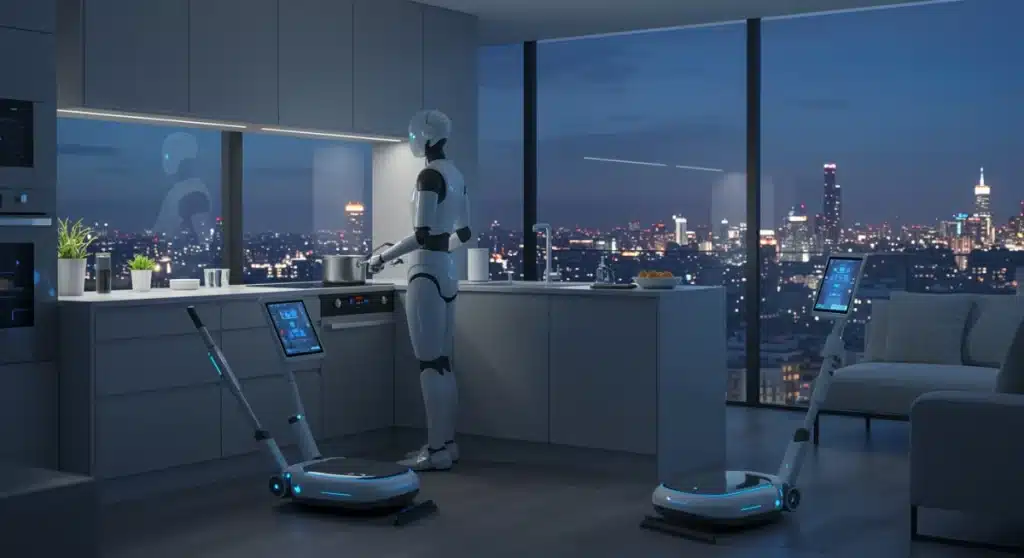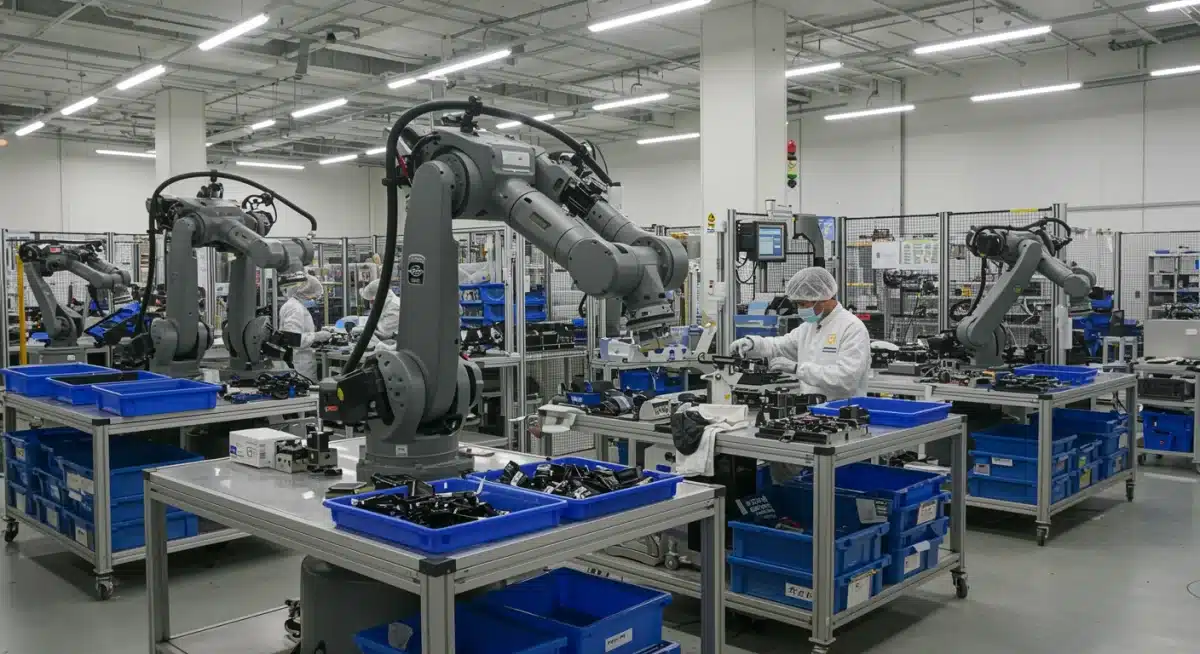Robotics in Daily Life 2025: Shaping Homes & Workplaces

The 2025 forecast for robotics in daily life indicates a rapid integration of automation into homes and workplaces, transforming routine tasks, enhancing efficiency, and redefining human-robot interaction across various sectors.
The landscape of our daily existence is on the cusp of a profound transformation. By 2025, the integration of
Robotics in Daily Life is poised to redefine our homes and workplaces.
Robotics in the Home: Smart Assistants and Beyond
As of early 2024, smart home devices have already laid the groundwork for automation. However, the 2025 forecast indicates a significant leap forward, moving beyond voice-activated speakers to more sophisticated robotic companions. These advancements are set to automate routine household chores and provide personalized assistance.
The next generation of domestic robots will feature enhanced AI capabilities, allowing them to learn preferences and adapt to individual household needs. This means a more intuitive and integrated smart home experience, where robots are not just tools but active participants in managing daily life.
Advanced Domestic Robots
- Cleaning and Maintenance: Robotic vacuum cleaners and mops will become more autonomous, navigating complex layouts and handling various surfaces with improved efficiency.
- Personal Assistance: Robots equipped with advanced natural language processing will offer proactive reminders, manage schedules, and even provide companionship for elderly residents.
- Security and Monitoring: Mobile home security robots will patrol residences, offering real-time surveillance and anomaly detection, integrating seamlessly with existing smart home security systems.
Furthermore, kitchens are expected to see an increase in robotic assistance, from automated coffee makers that learn your morning routine to robotic arms capable of simple food preparation tasks. This integration aims to free up human time, allowing for focus on more engaging activities.
Workplace Automation: A Collaborative Future
The impact of robotics on the workplace by 2025 is projected to be substantial, shifting from simple task automation to a more collaborative model. Industries are rapidly adopting robots to enhance productivity, improve safety, and address labor shortages.
This evolution is not about replacing human workers entirely but rather augmenting their capabilities. Collaborative robots, or cobots, are at the forefront of this change, designed to work alongside humans in shared spaces, performing repetitive or dangerous tasks.
Key Sectors Embracing Automation
- Manufacturing: Cobots are streamlining assembly lines, improving precision, and reducing physical strain on workers. They are easily reprogrammable, offering flexibility for diverse production needs.
- Logistics and Warehousing: Autonomous mobile robots (AMRs) are optimizing inventory management, order fulfillment, and material transport, significantly speeding up supply chain operations.
- Healthcare: Robotic assistants are aiding in surgical procedures, dispensing medications, and assisting with patient care, thereby enhancing efficiency and reducing the risk of human error in critical environments.
The integration of AI with robotics in the workplace allows for predictive maintenance, optimized scheduling, and real-time data analysis, leading to more informed decision-making and continuous improvement in operational processes.
Ethical Considerations and Societal Impact
As Robotics in Daily Life becomes more pervasive by 2025, ethical considerations and societal impacts are paramount. Discussions around job displacement, data privacy, and the potential for algorithmic bias are gaining urgency among policymakers and researchers.
Ensuring a just transition for workers affected by automation and establishing robust ethical guidelines for AI-powered robots are critical challenges that require immediate attention. The goal is to maximize the benefits of robotics while mitigating potential harms.
Addressing Ethical Challenges
- Job Displacement: Governments and educational institutions are exploring reskilling and upskilling programs to prepare the workforce for new roles created by automation.
- Privacy Concerns: Regulations are being developed to govern how robotic devices collect and utilize personal data, aiming to protect individual privacy rights.
- Algorithmic Bias: Researchers are actively working to develop fair and transparent AI algorithms to prevent discrimination and ensure equitable outcomes in automated systems.
Public perception and acceptance will also play a significant role in the successful integration of robotics. Open dialogue and transparent development practices are essential for building trust and fostering a positive relationship between humans and robots.
Advancements in AI and Sensor Technology
The rapid evolution of artificial intelligence and sensor technology is a primary driver behind the expanded capabilities of Robotics in Daily Life by 2025. These technological breakthroughs enable robots to perceive, understand, and interact with their environments with unprecedented sophistication.
AI algorithms are becoming more efficient, allowing robots to process vast amounts of data in real-time, learn from experience, and make autonomous decisions. This intelligence is crucial for robots operating in dynamic and unpredictable environments, such as homes and public spaces.

Key Technological Enablers
- Computer Vision: Enhanced cameras and vision systems enable robots to recognize objects, faces, and gestures, crucial for navigation and human-robot interaction.
- Tactile Sensors: Advanced sensors provide robots with a sense of touch, allowing for delicate manipulation of objects and safer interaction with humans.
- Natural Language Processing (NLP): Significant improvements in NLP empower robots to understand and respond to human speech more naturally, facilitating seamless communication.
These advancements are not just about making robots smarter but also about making them more adaptable and user-friendly. The focus is on creating robots that can seamlessly integrate into human routines without requiring extensive technical expertise from users.
Robotics in Public Spaces and Infrastructure
Beyond homes and workplaces, Robotics in Daily Life is extending into public spaces and infrastructure management by 2025. This includes applications in urban services, transportation, and environmental monitoring, promising more efficient and responsive public services.
Cities are exploring how robotics can address challenges such as waste management, public safety, and infrastructure maintenance. These deployments aim to improve the quality of urban living and create smarter, more sustainable communities.
Public Sector Applications
- Urban Logistics: Autonomous delivery robots are being piloted in various cities for last-mile delivery of goods, reducing traffic congestion and emissions.
- Environmental Monitoring: Drones and robotic sensors are collecting data on air quality, water pollution, and wildlife, providing crucial insights for environmental protection.
- Public Safety: Robotic patrols and surveillance systems are assisting law enforcement in monitoring large public gatherings and responding to emergencies, augmenting human capabilities.
The development of robust and secure robotic systems for public use is a key priority. Ensuring these systems are resilient to cyber threats and operate reliably in diverse conditions is essential for their widespread adoption and public trust.
The Economic Impact of Automation by 2025
The economic implications of expanded Robotics in Daily Life by 2025 are complex and multifaceted. While concerns about job displacement persist, automation is also driving economic growth through increased productivity, innovation, and the creation of new industries.
Investment in robotics and AI technologies is surging, leading to the development of new products and services. This creates opportunities for businesses to optimize operations, reduce costs, and gain competitive advantages in global markets.
Economic Drivers and Opportunities
- Productivity Growth: Robots perform tasks faster and more consistently than humans, leading to significant increases in output and efficiency across various sectors.
- New Job Creation: While some jobs may be automated, new roles in robot development, maintenance, programming, and ethical oversight are emerging, requiring specialized skills.
- Innovation and R&D: The demand for advanced robotics fuels research and development, pushing the boundaries of what is possible and leading to breakthroughs in related fields.
Furthermore, the adoption of robotics can enhance the competitiveness of industries, allowing companies to keep production onshore and improve supply chain resilience. This can lead to broader economic benefits, including higher wages in skilled roles and improved living standards.
| Key Aspect | 2025 Forecast Impact |
|---|---|
| Domestic Robotics | Enhanced smart home assistants and automated chore management becoming commonplace. |
| Workplace Automation | Increased collaboration between humans and cobots in manufacturing, logistics, and healthcare. |
| Ethical Considerations | Growing focus on job transition, data privacy, and algorithmic bias in robotic deployment. |
| Economic Impact | Productivity growth and new job creation in robotics and AI sectors. |
Frequently Asked Questions About Robotics in Daily Life by 2025
By 2025, domestic robots will largely automate chores like cleaning, cooking assistance, and smart home management. This will free up significant human time, allowing individuals to focus on leisure, personal development, or more complex tasks, fundamentally altering daily household rhythms and efficiency.
While some routine jobs may be automated, the 2025 forecast suggests a shift towards new roles in robot maintenance, programming, and human-robot collaboration. Automation will boost productivity, create new industries, and necessitate workforce upskilling rather than widespread unemployment, fostering a collaborative work environment.
Yes, as robots become more integrated into daily life, privacy concerns are a major focus. Developers and policymakers are actively working on robust regulations and secure data handling protocols to protect personal information collected by domestic and public robots, ensuring user trust and data integrity.
By 2025, manufacturing, logistics, and healthcare are expected to see the most significant robotic advancements. Cobots in factories, autonomous mobile robots in warehouses, and surgical/patient care robots in hospitals will drive efficiency, safety, and innovation across these critical sectors, transforming operations.
AI advancements will empower robots with superior perception, decision-making, and natural language understanding by 2025. This will enable more intuitive human-robot interaction, greater autonomy in complex tasks, and adaptability to dynamic environments, making robots more versatile and integrated into our daily routines.
What This Means
The rapid integration of robotics into our daily lives by 2025 signifies a pivotal moment in technological evolution. This isn’t merely an incremental change but a fundamental reshaping of how we interact with our homes, perform our jobs, and navigate public spaces. Stakeholders, from individuals to governments and industries, must actively engage in understanding and guiding this transformation. The ongoing developments in AI and sensor technology will continue to accelerate this trend, demanding proactive adjustments in education, policy, and ethical frameworks to harness the full potential of robotics for a more efficient and enhanced society.





